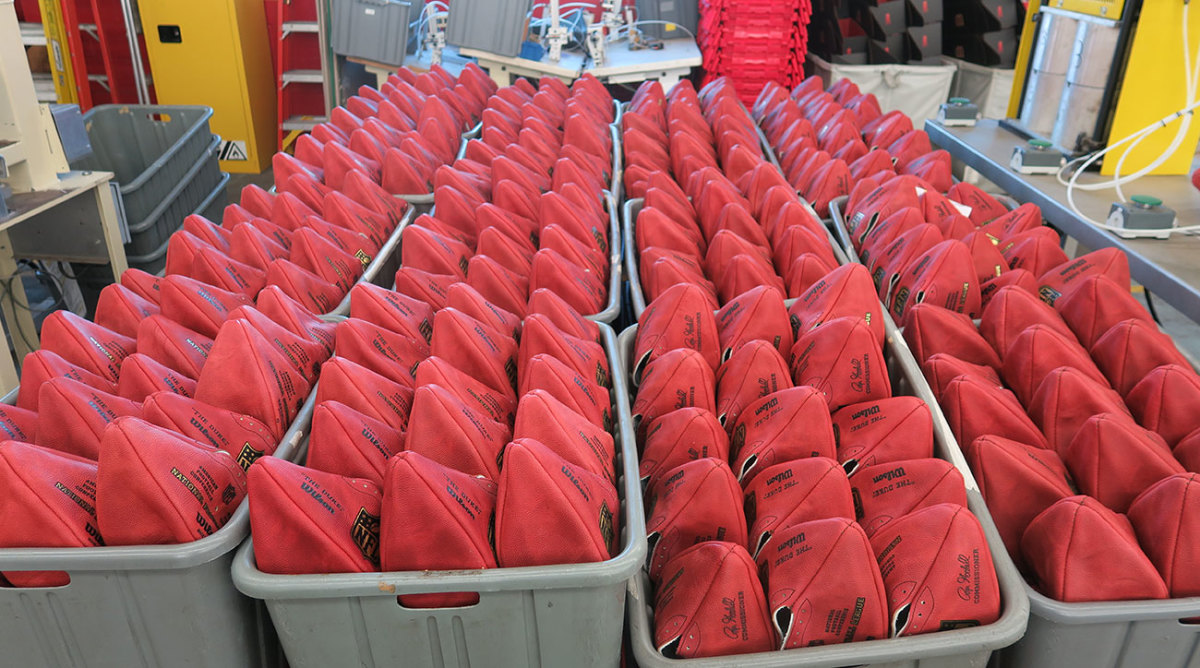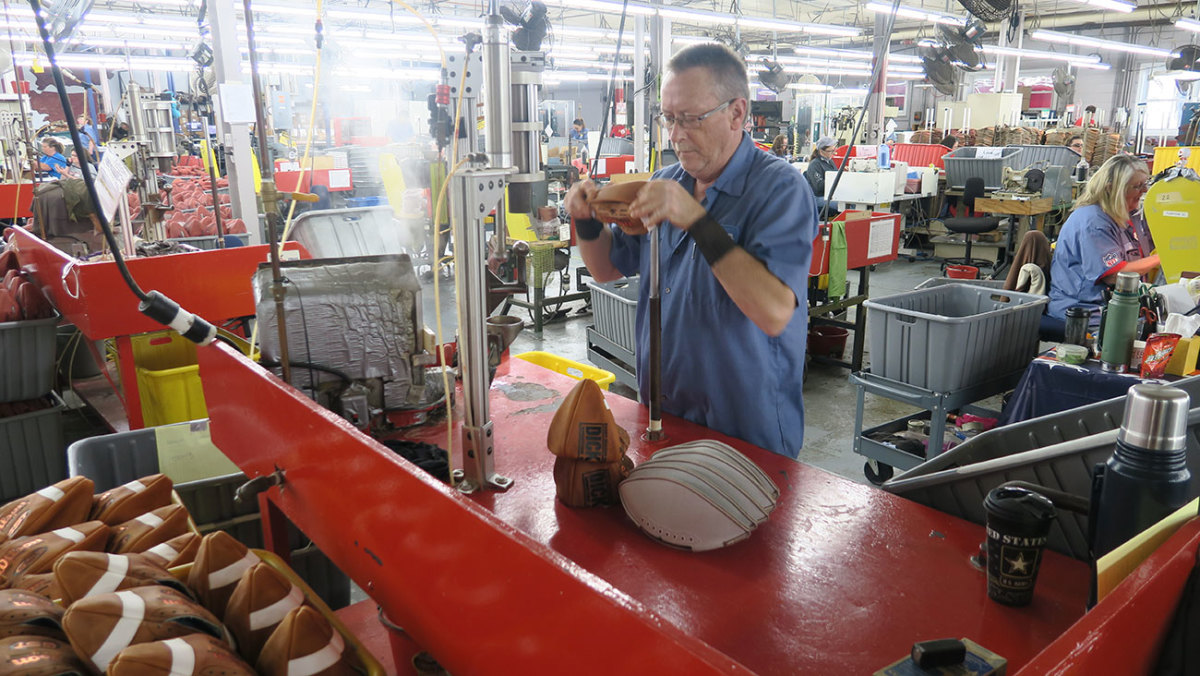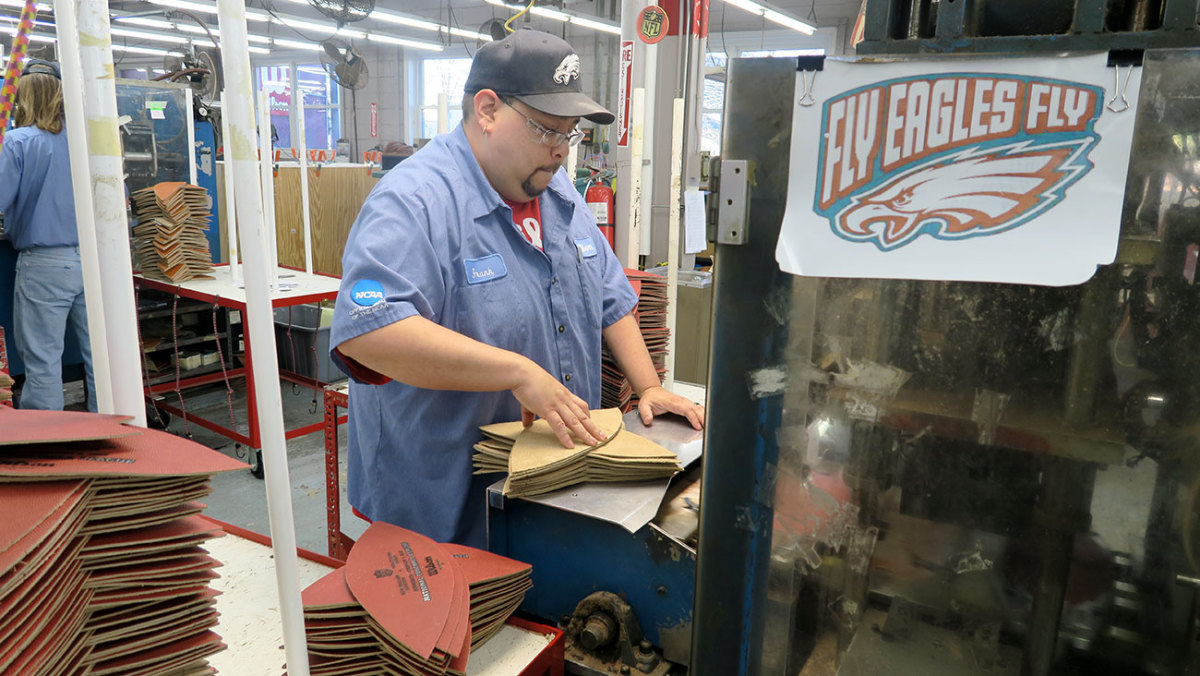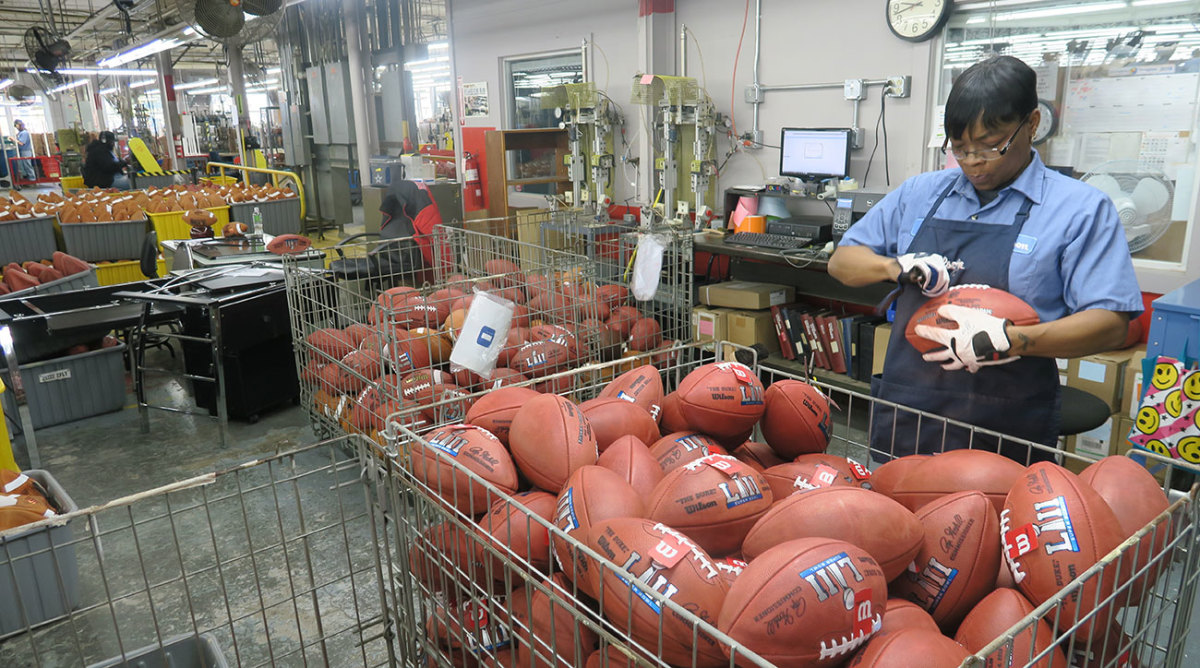The Super Bowl Is a Showcase for Ada, Ohio, the Town Where Footballs Are Born

The MMQB is on the road to Super Bowl 52. Follow along on Twitter, Facebook and Instagram and find all of our road trip content here.
ADA, Ohio — When David Tyree leaped into the air to complete the Helmet Catch, pinning the ball with one hand against his head in the final minutes of Super Bowl XLII, broadcasters and fans heaped praise on the Giants receiver for a play that defied belief. But from his seat in the Super Bowl crowd in Glendale, Ariz., Dan Riegle thought differently. Wow, what an amazing football. “That must be a great football, [for Tyree] to be able to grip that with one hand and catch it right against your helmet,” Riegle says.
He felt the same way when he watched Odell Beckham Jr. make his famous three-finger, falling-backward grab in a 2014 Giants-Cowboys game. “I know Odell is good, but to be able to grab that thing like that right out of the air … ” Riegle shakes head. “When I see those kinds of plays, it makes me feel good.”
As the plant manager for the Wilson Sporting Goods factory, Riegle is inclined to credit the ball, not the baller, for remarkable plays. After all, that’s his baby out there. Every football made by Wilson, the official provider for the NFL and NCAA, is produced at the plant runs in this small town in northwest Ohio.

It’s a quiet Friday morning in the boss’s office at the football factory. The 108 official Super Bowl game balls were sent to the Eagles and the Patriots soon after their conference championship victories, and now the plant is busy producing retail balls, sold for $179.99 at sporting goods stores, and at pop-up shops all over the Twin Cities this week. Visitors to Wilson are greeted by a wall of media coverage of the factory throughout its six decades in Ada. Two mounted bucks stare down from the wood-paneled walls at Riegle’s desk, where he’s managed the plant for the last 37 years. Super Bowl season is a popular time at Wilson, and the guest sign-in sheet shows several local radio and TV outlets stopping by in recent days.
Riegle, voted Mr. Football as a receiver at Arlington (Ohio) High for two straight years, has spent nearly his entire working life making footballs. Now 64, he will be retiring in March to spend more time with his two grandsons and working on his corn and soybean farm 20 miles down the road. But today he’s focused on one last push to the Super Bowl, and a few more tours of the factory he calls home.
Riegle grabs a pair of safety glasses as he opens the door onto the factory floor. Old silver sewing machines clang and whir as employees methodically stich together panels of leather. A steam press loudly releases after stamping Super Bowl LII logos onto leather panels. An old-fashioned school-type bell rings to dismiss a shift of employees for their 10-minute break. Brand new balls awaiting laces and air pressure are neatly arranged in several rows of bins, like newborn babies lined up in incubators at a maternity ward.
“People tend to think, oh, it all just goes into a machine and comes out the other end as a football,” Riegle says. “But that couldn’t be further from the truth.”
Football-making is a people business. Riegle likes to say it’s not really a job, it’s a craft. Some two dozen people have a hand in each ball that’s made in Ada, and 3,000 balls are finished each day over a multistep process that takes three to five days from start to finish for each ball. Footballs are the only product produced at the Ada plant, and the process hasn’t changed much since 1941, when Wilson became the NFL’s official maker. You’ve got the cutters, the stampers, the sewers, the turners, the lacers, the molders, the inspectors and the packagers. Each group has a specialized job in the cycle.

The cutters use stencils that look like football-shaped cookie-cutters to pierce panels out of the leather hides, four per football. The stampers take the panels and insert them into a complicated machine that presses a shiny foil design onto the balls—on this day it’s the silver and blue Super Bowl LII logo. The sewers stitch the four panels together inside out, so the seams don’t show. The sewing job is so detailed and complicated that it can take three to five months for an employee to perfect it. The turners take the inside-out shells and turn them right side out. The lacers double-lace each ball. The molders inflate them to exactly 13 PSI inside a special mold. (Riegle says he got hundreds of calls during Deflategate, questioning the accuracy of the air pressure of footballs at the factory.) The team of inspectors study each football closely to ensure every detail is cosmetically and functionally perfect.
The standards are high. Botched balls that fail to pass inspection are known as blems, or blemishes. Riegle says there’s only a small percentage, thanks to the inspections that happen at each stage of the process. Once a ball passes inspection, the packagers box up each ball for retail or sort them to ship off to teams.
Employees often spend their entire Wilson careers at the same station in the cycle, and job openings at the plant are rare—the average employee tenure is about 20 years, and, says Riegle, “the only time we have a job open is when somebody retires.”
Michelle Burkett, one of the two cutters working the Friday shift, has put in 43 years at Wilson. She was a lacer until she injured her arm, then switched to cutter, a less wrist-intense job. Burkett smiles as she spreads each hide across her workspace. She points out that hidden in the pebbled pattern of each tanned hide are small Wilson Ws. Her favorite days are when tours come through the factory and she gets to share her insider Wilson facts with new people.
Along the east side of the factory runs a street named Charles Moore Turn, dedicated to former Wilson employee Charles Moore, who performed the most physically challenging job—“turning” the ball—for 43 years.
It takes real muscle to wrestle the stiff pigskin shell right-side out, but the turners make it look as smooth as flipping a pancake. When NFL players come through the Wilson factory on tours, Riegle will let them attempt to turn a ball. “They end up with it in a knot, and we have to get it straightened out for them,” Riegle says. “When they leave here they have an appreciation for the product they are using.”

Even offensive lineman with forearms the size of small tree trunks can’t wrangle the shell into place. To soften up the ball, the turner places it into a steam box for 25 seconds. He then takes the warm ball and hammers in the two pointy ends, and places one end on the top of a pole attached to a table, using the pole to quickly work the leather right-side out through the gap where the laces will go. Each turner will flip 500 to 600 balls each day. Riegle estimates Moore, the 43-year legend, turned five million balls in his career.
But the most enviable position in the factory might be lacer, because they work with an already right-side out and sewn-together ball, and get the satisfaction of completing the last step in the manual production process. Sally Matthews, 56, gracefully weaves long white laces in and out, in and out. She works quickly, her fingers wrapped with white tape so she can get a better grip on the rough leather and laces. Her taped-up hands make her look almost as much like a professional athlete as the player who will carry or catch the ball she’s working on.
Matthews has been doing the job at Wilson for a year and a half now. Employees are paid by the piece, to incentivize meeting quota, and Matthews says she’s competitive with herself. “The first week I started, I probably did, maybe 30 balls each day,” Matthews says. “But now I do, like, 150.”
Employees usually wear light blue button-down work shirts with their name stitched in a powder blue cursive script, but Fridays are a more casual uniform day, and most employees are sporting red Wilson t-shirts, or Ohio State Buckeyes jerseys. A few workers, however, are showing their Super Bowl 52 colors: Frank Guerra, 41, wears a black Philadelphia Eagles hat and has taped a small “Fly Eagles Fly” laminated poster to his workstation. Over in the lacing section, another employee has decorated her space with several Patriots Super Bowl rally towels.

Guerra is a stamper, so he runs the machine that prints logos on each leather panel through a 14-step stamping process. “It is pretty tedious work,” he says. “We have to make sure that everything is lined up. My station has 14 holders, so I have to make sure that all of my 14 holders are identical. It’s hard work. You have to have a good quality eye.”
Even though the job can be monotonous, Guerra says he never gets football fatigue. “I love what I do—I take pride in it,” he says. “I have always been into football, and it is just more exciting knowing I had a part in making the football.”
The football trade is what sets Ada apart from Alger and Dunkirk and McGuffey and other towns in Hardin County, marked by miles of corn and soybean fields. Wilson pride is evident all over town. One of Ada’s two water towers reads MADE IN ADA and is painted with the Wilson logo and the NFL shield. The standard green town sign stands next to one that that marks Ada as “Home of the Wilson NFL Football.”
“There is a special meaning to everybody here that the people that work here live out in the Midwest amongst the cornfields, yet we make such a high-exposure product,” Reigle says.
Everyone in Ada knows someone who works for Wilson. The workers often say they feel like family, and many times they really are family. On this Friday morning shift, two of the six turners were related, an uncle and nephew.

Riegle will travel to Minneapolis for Super Bowl LII with a team of his top Wilson employees. They’ll perform their art for crowds at the NFL’s Super Bowl Experience in the days leading up to the game.
Back in town, locals will gather for the second annual Made in Ada Wilson Football Festival, held on the day before the Super Bowl. They’ll tailgate at the train depot and screen football movies at the town theater. Kids will try to stay awake late into the night; the town will usher in Super Bowl Sunday, counting down the final seconds until midnight, with a New Year's Eve-style ball drop. Only this ball is a 10-foot long Wilson football lantern. Most importantly, it’s made in Ada.
Question or comment? Email us at talkback@themmqb.com.
